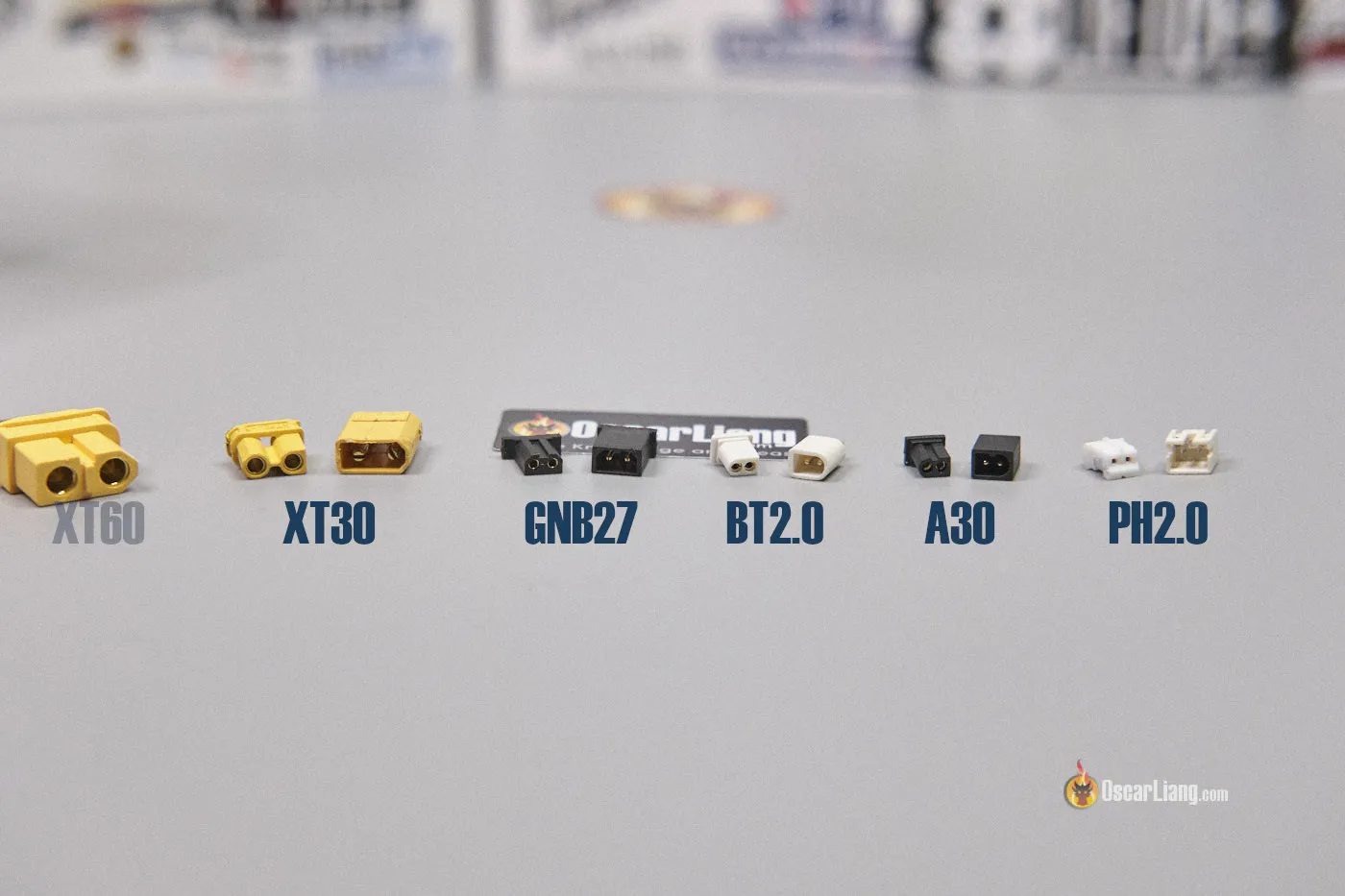A30, BT2.0, PH2.0, GNB27, and XT30 are common battery connectors used in Tiny Whoops and many other micro FPV drones. My objective was to test these connectors and compare their performance, to determine which LiPo connector provides the most minimal resistance, least amount of voltage sag, and efficient performance,
Table of Contents
Connectors Under Test
Here’re are the weights of the LiPo connectors I tested, which includes both the male and female connectors. All measurements were taken using a cheap priced digital scale, with an accuracy of 0.1g.
- PH2.0: 0.4g
- BT2.0: 0.6g
- A30: 0.6g
- GNB27: 0.8g
- XT30: 1.6g
You can learn more about these connectors here:
Testing Method
I used the SkyRC D200Neo charger and the BD350 Battery Analyzer for this testing, which allows me to log data and plot graphs. However the BD350 only works on a minimum of a 2S battery, that’s why you are going to see the test were done with 2S LiPo and not 1S.
To maintain consistency throughout the testing, I chose to use the same battery for all the connectors (a 2S 300mAh LiHV battery). The original connector on this battery was replaced with the connectors under test.
During the test, the battery was discharged at a constant current of 12A, until the voltage dropped to 6V (3.0V per cell). This 12A load is a reasonable representation of the demands placed on a 1S or 2S micro quad. A typical tiny whoop draws fewer amps than this.
The primary performance metric we’ll be comparing is voltage sag. A connector with a higher resistance will display a higher voltage sag, which is indicative of subpar performance. It will also reach the minimal voltage early before completely discharging its capacity, resulting in less flight time.
Final Verdict
PH2.0
Looking at the results, it’s clear that the PH2.0 (solid pin) connector falls short when compared to the others we tested. It demonstrated a higher voltage sag, primarily due to its higher resistance, which subsequently led to a marginal reduction in flight time as well.
Interestingly, the rest of the connectors – namely BT2.0, A30, GNB27, and XT30 – performed quite similarly when subjected to the 12A load. Given this, on a Tiny Whoop, you’re unlikely to perceive any noticeable differences between these connectors in the electrical performance. However, when weight becomes a factor, the A30 and BT2.0 connectors stand out as the clear winners.
XT30
As we look closer, the XT30 displayed the least voltage sag, which aligns with expectations given that it’s also the heaviest connector in the group. But for tiny whoops, the small improvement doesn’t really justify the one gram extra weight, accounting for around 5% of a typical Tiny Whoop’s weight. Hence, XT30 is better suited for larger micros that draw higher currents, say 20A or higher, to truly take advantage of its low resistance. You can purchase XT30 connectors here: https://oscarliang.com/wires-connectors/#XT30-Connectors
GNB27
The GNB27 displayed similar performance to the BT2.0 and A30 in our testing, and it’s slightly heavier, so it makes more sense to use BT2.0 or A30 for tiny whoops and other 1S micros. Additionally, in my experience, the GNB27 connector is a bit harder to use than BT2.0, as it’s really tough to pull apart when swapping batteries.
A30 and BT2.0
BT2.0 seemed to perform ever so slightly better than the A30, but the difference was marginal and I believe it’s not significant enough to raise concerns. You can purchase A30 and BT2.0 connectors from these vendors: https://oscarliang.com/best-tiny-whoop/#LiPo-Battery-Connectors




5 comments
Useful. A few comments:
I doubt solid / folded PH pin makes much difference, it’s about contact area and pressure, in fact one could surmise that folded might have marginally higher surface area in the contact patch.
The actual JST PH spec shows how low the current rating on this connector is – nowhere near what is needed. I think it’s really designed for low current board interconnect.
But, WD40 on the connector (every time plugged in) does help PH performance. Tests I’ve done indicate that the connector works fine for a bit at high current, then the voltage drop shoots up. I surmise the reason is temp rises, then the contact area starts to tarnish, so resistance rises, more tarnishing, and so on. The WD40 probably provides a protective barrier stopping oxygen getting to the contact area.
It’s a pity so few suppliers support BT2.0. Didn’t know A30 was compatible though, useful. GNB do some A30 cells.
Nice test though I would have been interested in seeing an a30 hooked up to a bt2.0 on the quad side since they’re compatible.
I have been flying this for weeks, they are compatible.
What about this test: check connectors transition resistance while connector is brand new and then again after 10, 100, 1000 disconnect/connect cycles? This can be more informative about connectors durability in time.
Yes, I agree, someone should do this.